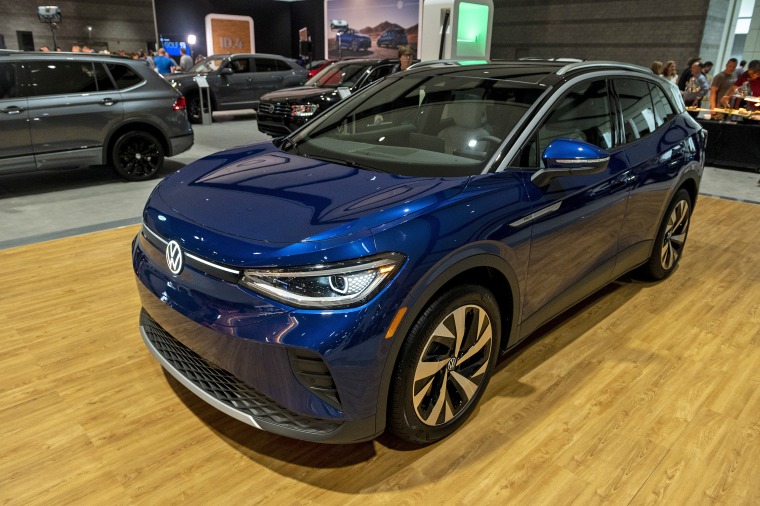With gas prices near record levels and no clear sign of how much higher they might go, a growing number of American motorists are looking for alternatives, including electric vehicles.
Nearly 1 in 5 shoppers who went to the research site Edmunds.com during the first week of March looked at hybrids, plug-in hybrids and EVs, an 18 percent increase over the previous week. Month over month, the increase was nearly 40 percent, according to the website.
And they found a lot more vehicles to choose from, as a flood of new electric models, in a wide range of sizes, styles and prices, have come on the market. They include the Kia EV6, Ford F-150 Lightning and Mercedes-Benz EQS. And more models are on the way. More than 50 are expected to be available by the end of the year.
For many drivers, the decision to buy an EV will be driven in large part by the answer to one question: Will I save money? On energy, immediately. But “you have to consider the total ownership cost,” said Carla Bailo, CEO of the Center for Automotive Research. And that’s where things can get complicated.
Here are some of the biggest factors to consider:
Purchase price. The sale price for an EV, on average, was $60,054 in February. That compared to $45,596 on average for all new vehicles, including electric ones, according to data from Edmonds. When compared to comparable gas models, EVs typically cost 10 to 15 percent more, although prices have been climbing steadily over the past couple of years and are expected to continue to rise. This week, for instance, Tesla announced it would raise prices on all its models. The Model 3, Tesla’s least expensive and most popular car, jumped $2,000 to $47,000.
Bailo believes the price gap between EVs and conventional automobiles will narrow, as battery costs drop and lower-priced models, some below $30,000, become available. She predicts that by the middle of the decade, “we’ll have parity” between comparable models.
Energy costs. Here’s where EVs have a clear and growing advantage. For example, the new Volkswagen ID.4 SUV, which starts at about $40,000, gets 250 miles per charge. With the average residential customer paying about 14 cents per kilowatt, it costs roughly $11 to fully charge the battery. Also, some customers qualify for discount charging rates. A comparable VW Tiguan SUV, which starts at about $26,000 and gets 26 mpg, would cost about $38 to fill up at $4 a gallon. If you drive 12,000 miles a year, you could expect to spend around $550 to power the ID.4, compared to $1,900 for the Tiguan.

Size. Energy efficiency varies widely; the bigger the vehicle, the more energy it will need. This is also true for gas models. So, while the Ford F-150 Lightning pickup will drain a battery faster than a compact Tesla Model 3 sedan, it will also save more per mile compared to a conventional Ford F-150, particularly during periods of high gas prices.
Home chargers. There are more home chargers coming to the market and prices are plunging. Expect to spend around $500 to $700 for the charger. But the larger cost may be wiring it up, depending on the age and construction of your home or apartment building and your current electric service.
Public chargers: Expect to pay at least twice as much to use a high-speed charger at a gas station or charging station — if you can find one — compared to charging at home. The tab for that Volkswagen ID.4, for instance, would be around $20 to $25. At the moment, most public chargers are slow “Level 2” chargers, which can take an hour to add just 10 to 15 miles in range. However, the network of fast chargers is growing quickly, and some of the newest EVs vehicles can add 200 miles range in less than 20 minutes.
Maintenance and repairs. EVs don’t require tune-ups, oil changes and some other types of routine maintenance. During the first year, an EV, on average, requires $254 in service and repairs versus $172 for a conventional model, according to data from We Predict, a research firm. That’s largely because any issues with EVs are likely to be discovered early on, whereas conventional vehicles tend to develop problems later. After three years, EV owners, on average, spent $378 on service and repairs compared to $615 on average for gas models, according to We Predict.
Insurance. Rates vary by state and other factors, but EV owners typically pay a premium. One reason: EVs tend to cost more than their nonelectric counterparts. Some analysts also believe insurance companies are being cautious because they still have relatively little experience with electric autos or data on which to base their actuarial tables.
Incentives. EV buyers stand to get as much as $7,500 in federal tax credits, depending on the type of vehicle they buy. Some automakers, notably Tesla and General Motors, have crossed a sales threshold that phased out the federal incentives on their products. Congress is considering a measure that would restore their credits and possibly boost incentives as high as $12,500, but chances of it passing are slim.
More than a dozen states also offer incentives, including California, Delaware, Minnesota and Oregon. On the flip side, 28 states have enacted special registration fees as high as $225 for EVs. The fees are intended to help recoup the taxes most drivers pay when they fill up.
So, to buy or not to buy, if savings is the goal? The more you drive, the more you will save on energy. And the higher gas prices go, the faster you’ll offset the additional, upfront costs of an EV. Also, government incentives can sometimes completely make up for the higher price tag.
All things considered, if you drive at least 12,000 miles a year, have a home charger and qualify for federal tax credits, experts say you have a good chance of being in the black within two or three years, compared to buying and operating a comparable gas vehicle.
